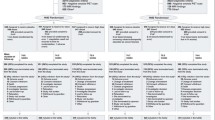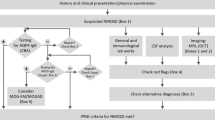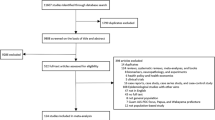Abstract
Background
Several studies indicated that multiple sclerosis (MS) is frequently associated with other autoimmune diseases. However, it is little known if the coexistence of these conditions may influence the radiologic features of MS, and in particular the brain volumes.
Objectives
To evaluate the effect of autoimmune comorbidities on brain atrophy in a large case–control MS population.
Methods
A group of MS patients affected by a second autoimmune disorder, and a control MS group without any comorbidity, were recruited. Patients underwent a brain MRI and volumes of whole brain (WB), white matter (WM), and gray matter (GM) with cortical GM were estimated by SIENAX.
Results
The sample included 286 MS patients, of which 30 (10.5%) subjects with type 1 diabetes (T1D), 53 (18.5%) with autoimmune thyroiditis (AT) and 4 (0.1%) with celiac disease. Multiple regression analysis found an association between T1D and lower GM (p = 0.038) and cortical GM (p = 0.036) volumes, independent from MS clinical features and related to T1D duration (p < 0.01), while no association was observed with AT and celiac disease.
Conclusions
Our data support the importance of considering T1D as possible factors influencing the brain atrophy in MS. Further studies are needed to confirm our data and to clarify the underlying mechanisms.
Similar content being viewed by others
References
Haider L, Zrzavy T, Hametner S et al (2016) The topography of demyelination and neurodegeneration in the multiple sclerosis brain. Brain 139(Pt 3):807–815
Stinissen P, Raus J, Zhang J (1997) Autoimmune pathogenesis of multiple sclerosis: role of autoreactive T lymphocytes and new immunotherapeutic strategies. Crit Rev Immunol 17(1):33–75
Lucchinetti CF, Brück W, Rodriguez M et al (1996) Distinct patterns of multiple sclerosis pathology indicates heterogeneity on pathogenesis. Brain Pathol 6(3):259–274
Lemus HN, Warrington AE, Rodriguez M (2018) Multiple sclerosis: mechanisms of disease and strategies for myelin and axonal repair. Neurol Clin 36(1):1–11
Marrosu MG, Cocco E, Lai M et al (2002) Patients with multiple sclerosis and risk of type 1 diabetes mellitus in Sardinia, Italy: a cohort study. Lancet 359(9316):1461–1465
Tettey P, Simpson S Jr, Taylor BV et al (2015) The co-occurrence of multiple sclerosis and type 1 diabetes: shared aetiologic features and clinical implication for MS aetiology. J Neurol Sci 348(1–2):126–131
Sardu C, Cocco E, Mereu A et al (2012) Population based study of 12 autoimmune diseases in Sardinia, Italy: prevalence and comorbidity. PLoS ONE 7(3):e32487
Marrie RA, Reider N, Cohen J et al (2015) A systematic review of the incidence and prevalence of autoimmune disease in multiple sclerosis. Mult Scler. 21(3):282–293
Ramagopalan SV, Dobson R, Meier UC et al (2010) Multiple sclerosis: risk factors, prodromes, and potential causal pathways. Lancet Neurol. 9(7):727–739
Steri M, Orrù V, Idda ML et al (2017) Overexpression of the cytokine BAFF and autoimmunity risk. N Engl J Med 376(17):1615–1626
Karni A, Abramsky O (1999) Association of MS with thyroid disorders. Neurology. 53(4):883–885
Dorman JS, Steenkiste AR, Burke JP, Songini M (2003) Type 1 diabetes and multiple sclerosis: together at last. Diabetes Care 26(11):3192–3193
Nielsen NM, Westergaard T, Frisch M et al (2006) Type 1 diabetes and multiple sclerosis: a Danish population-based cohort study. Arch Neurol 63:1001–1004
Hussein WI, Reddy SS (2006) Prevalence of diabetes in patients with multiple sclerosis. Diabetes Care 29:1984–1985
Lampis R, Morelli L, De Virgiliis S et al (2000) The distribution of HLA class II haplotypes reveals that the Sardinian population is genetically differentiated from the other Caucasian populations. Tissue Antigens 56(6):515–521
Kotelnikova E, Kiani NA, Abad E et al (2017) Dynamics and heterogeneity of brain damage in multiple sclerosis. PLoS Comput Biol 13(10):e1005757
De Stefano N, Stromillo ML, Giorgio A et al (2016) Establishing pathological cut-offs of brain atrophy rates in multiple sclerosis. J Neurol Neurosurg Psychiatry 87(1):93–99
Pichler A, Khalil M, Langkammer C et al (2017) The impact of vascular risk factors on brain volume and lesion load in patients with early multiple sclerosis. Mult Scler. 1:1352458517736149
Zivadinov R, Raj B, Ramanathan M et al (2016) Autoimmune comorbidities are associated with brain injury in multiple sclerosis. AJNR Am J Neuroradiol 37(6):1010–1016
Cocco E, Sardu C, Massa R et al (2011) Epidemiology of multiple sclerosis in south-western Sardinia. Mult Scler. 17(11):1282–1289
Polman CH, Reingold SC, Banwell B et al (2011) Diagnostic criteria for multiple sclerosis: 2010 revisions to the McDonald criteria. Ann Neurol 69(2):292–302
Kurtzke JF (1983) Rating neurologic impairment in multiple sclerosis: an expanded disability status scale (EDSS). Neurology 33(11):1444–1452
Cendrowski WS (1986) Progression index and disability status in multiple sclerosis: a resurvey of 207 patients in central Poland. Schweiz Arch Neurol Psychiatr (1985). 137(4):5–13
Smith SM, Zhang Y, Jenkinson M et al (2002) Accurate, robust, and automated longitudinal and cross-sectional brain change analysis. Neuroimage. 17(1):479–489
Sahraian MA, Owji M, Naser Moghadasi A (2016) Concomitant multiple sclerosis and another autoimmune disease: does the clinical course change? Clin Neurol Neurosurg 150:9295
Giorgio A, De Stefano N (2013) Clinical use of brain volumetry. J Magn Reson Imaging 37(1):1–14
De Stefano N, Airas L, Grigoriadis N et al (2014) Clinical relevance of brain volume measures in multiple sclerosis. CNS Drugs 28:147–156
Winer S, Astsaturov I, Cheung R et al (2001) Type I diabetes and multiple sclerosis patients target islet plus central nervous system autoantigens; nonimmunized nonobese diabetic mice can develop autoimmune encephalitis. J Immunol. 166(4):2831–2841
Magliozzi R, Howell OW, Reeves C et al (2010) Gradient of neuronal loss and meningeal inflammation in multiple sclerosis. Ann Neurol 68(4):477–493
Pell GS, Lin A, Wellard RM et al (2012) Age-related loss of brain volume and T2 relaxation time in youth with type 1 diabetes. Diabetes Care 35(3):513–519
Perantie DC, Wu J, Koller JM, Lim A, Warren SL, Black KJ, Sadler M, White NH, Hershey T (2007) Regional brain volume differences associated with hyperglycemia and severe hypoglycemia in youth with type 1 diabetes. Diabetes Care 30(9):2331–2337
Jefferson AL, Massaro JM, Wolf PA et al (2007) Inflammatory biomarkers are associated with total brain volume: the Framingham Heart Study. Neurology 68:1032–1038
Marrie RA, Rudick R, Horwitz R et al (2010) Vascular comorbidity is associated with more rapid disability progression in multiple sclerosis. Neurology 74:1041–1047
Author information
Authors and Affiliations
Corresponding author
Ethics declarations
Conflicts of interest
Dr. Lorefice has received speaker fees from Teva and serves on scientific advisory boards for Biogen. Dr. Fenu has received honoraria for consultancy from Novartis and for speaking from Merck Serono and Teva. Dr. Frau serves on scientific advisory boards for Biogen, and has received honoraria for speaking from Merck Serono and Teva. Dr. Coghe has received speaker fees from Teva and Almirall. Professors Cocco and Marrosu have received honoraria for consultancy or speaking from Bayer, Biogen, Novartis, Sanofi, Genzyme, Serono, and Teva. Dr. Barracciu, Dr. Musu, Dr. Pitzalis, Dr. Sechi, and Dr. Scalas have nothing to disclose.
Ethical standards
The study was performed in accordance with the ethical standards statement.
Electronic supplementary material
Below is the link to the electronic supplementary material.
Rights and permissions
About this article
Cite this article
Lorefice, L., Fenu, G., Pitzalis, R. et al. Autoimmune comorbidities in multiple sclerosis: what is the influence on brain volumes? A case–control MRI study. J Neurol 265, 1096–1101 (2018). https://doi.org/10.1007/s00415-018-8811-1
Received:
Revised:
Accepted:
Published:
Issue Date:
DOI: https://doi.org/10.1007/s00415-018-8811-1




